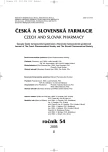Effect of Manganese (II), Cobalt (II), and Nickel (II) Ions on the Growth and Production of Coumarins in the Suspension Culture of Angelica archangelica L.
Vliv manganatých, kobaltnatých a nikelnatých iontů na růst a produkci kumarinů v suspenzní kultufie Angelica archangelica L.
Rostlinná buňka reaguje na zvýšenou koncentraci kovů v prostředí různými mechanizmy. Patří mezi ně zvýšení tvorby proteinů tepelného šoku, metalothioneinů, fytochelatinů, aminokyselin (cysteinu, histidinu), organických kyselin (citronové, jablečné) nebo sekundárních metabolitů. Poslední mechanizmus je zkoumán pro možnost využití v explantátových kulturách ke stimulaci sekundárního metabolizmu, který je zdrojem farmaceuticky významných látek. V práci byly testovány manganaté (0; 0,1; 0,2; 0,5; 1; 2; 5; 10; 20 a 50 mM/l média), kobaltnaté a nikelnaté ionty (0; 0,1; 0,5; 1; 5; 10; 50; 100; 200 a 500 μM/l média) jako potenciální elicitory produkce kumarinů. Současně byla sledována toxicita těchto kovů pro kulturu hodnocením vlivu na růst (charakterizován čerstvou a suchou hmotností biomasy na konci čtrnáctidenní kultivace). Kultury byly kultivovány ve tmě a na světle. Bylo zjištěno, že růst kultur není ovlivněn manganem v koncentracích 0 až 2 mM, poté mírně klesá, při koncentraci 50 mM je o 20 % nižší při kultivaci ve tmě a o 30 % při kultivaci na světle ve srovnání s kontrolou. Kobalt v koncentracích 0 až 50 μM neovlivňuje významně růst kultury, vyšší koncentrace snižují nárůst biomasy, výrazněji při kultivaci na světle (při 500 μM Co o 60 %, ve tmě jen o 30 % ve srovnání s kontrolami). Nikl v koncentracích 0,1 až 200 μM neovlivňuje růst, v koncentraci 500 μM jej snižuje přibližně o 30 % ve srovnání s kontrolou při kultivaci na světle i ve tmě. Produkce kumarinů nebyla žádným kovem stimulována v porovnání s kontrolními kulturami. Pouze odstranění manganu z média v kultuře kultivované ve tmě zvýšilo produkci asi o 15 % oproti kontrole.
Klíčová slova:
Angelica archangelica L. – suspenzní kultura – růst – produkce kumarinů – mangan – kobalt – nikl – sekvenční injekční analýza
Authors:
T. Siatka; M. Kašparová; H. Sklenářová 1; P. Solich 1
Authors‘ workplace:
Katedra farmakognozie Farmaceutické fakulty Univerzity Karlovy, Hradec Králové
; Katedra analytické chemie Farmaceutické fakulty Univerzity Karlovy, Hradec Králové
1
Published in:
Čes. slov. Farm., 2005; 54, 47-51
Category:
Original Articles
Overview
The plant cell reacts to an increased concentration of metals in the environment by various mechanisms. They include an increase in the formation of heat-shock proteins, metallothioneins, phytochelatins, amino acids (cysteine, histidine), organic acids (citric, malic), or secondary metabolites. The latter mechanism is being investigated for its possible use in explant cultures for the stimulation of secondary metabolism, which is the source of substances of pharmaceutical importance. The study tested manganese (II) (0, 0.1, 0.2, 0.5, 1, 2, 5, 10, 20, and 50 mM in the medium), cobalt (II), and nickel (II) ions (0, 0.1, 0.5, 1, 5, 10, 50, 100, 200, and 500 μM in the medium) as potential elicitors of coumarin production. At the same time, toxicity of these metals for the culture was examined by evaluating their effect on growth (characterized by fresh and dry weight of biomass at the end of a two-week cultivation). Cultures were cultivated in the dark and in the light. It has been found that the growth of cultures is not influenced by manganese in concentrations ranging from 0 to 2 mM, then it slightly decreases, at a concentration of 50 mM it is lower by 20 % when cultivated in the dark and by 30 % when cultivated in the light in comparison with the control. Cobalt in concentrations of 0 to 50 μM does not significantly influence the growth of the culture, higher concentrations decrease the biomass yields, more markedly when cultivated in the light (at 500 μM Co by 60 %, in the dark only by 30 % in comparison with the controls). Nickel in concentrations of 0.1 to 200 μM does not influence growth, and in a concentration of 500 μM decreases it by approximately 30 % in comparison with the control both in the light and dark. Production of coumarins was not stimulated by any metal in comparison with the control cultures, only the removal of manganese from the medium in the culture cultivated in the dark increased production by about 15 % versus the control.
Key words:
Angelica archangelica L. – suspension culture – growth – coumarins – manganese – cobalt – nickel – sequential injection analysis
Labels
Pharmacy Clinical pharmacologyArticle was published in
Czech and Slovak Pharmacy

2005 Issue 1
Most read in this issue
- In situ Gelling Polymers for Ophthalmic Drops
- Enzymology of Production of Benzylisoquinoline Alkaloids
- Power Law Equation and Liberation Kinetics
- Prescription and Structure of Formulation of Medicinal Preparations in a Pharmacy II
